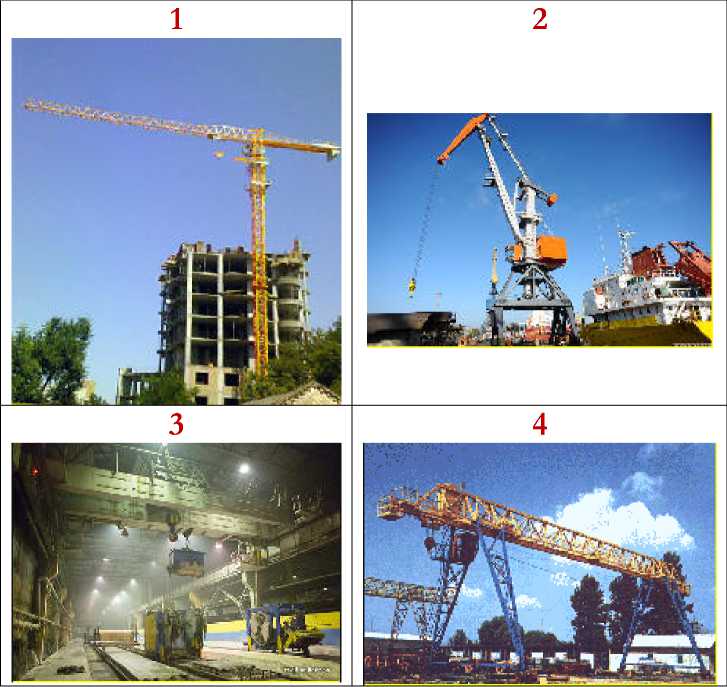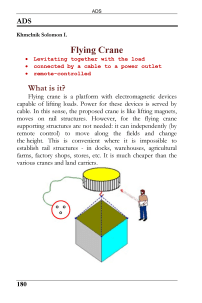Flying Crane
Автор: Khmelnik Solomon I.
Журнал: Доклады независимых авторов @dna-izdatelstwo
Рубрика: A.D.S
Статья в выпуске: 28, 2014 года.
Бесплатный доступ
Короткий адрес: https://sciup.org/148311849
IDR: 148311849
Текст статьи Flying Crane
Flying crane is a platform with electromagnetic devices capable of lifting loads. Power for these devices is served by cable. In this sense, the proposed crane is like lifting magnets, moves on rail structures. However, for the flying crane supporting structures are not needed: it can independently (by remote control) to move along the fields and change the height. This is convenient where it is impossible to establish rail structures - in docks, warehouses, agricultural farms, factory shops, stores, etc. It is much cheaper than the various cranes and land carriers.
What guarantees the possibility of creating a flying crane?
There is
-
• Known experiments;
-
• Scientific justification of such possibility (without violation of the known physical laws and without invention of new laws of physics);
-
• Calculation method;
-
• Calculation program;
-
• Sketches of several designs;
-
• New technologies.
Features
-
• The main characteristics - ratio of lifting force F to the own weight Р : X=F/P .
-
• Initial (according to the production date) value is Х=(1.5^2.5) ; for comparison: the cargo helicopter XH-17 "Flying Crane" has the value X=13000/24000=~0.5 .
-
• Initial (according to the production date) value of the lifting force is F=5 Kg .
-
• In future there should be no principal restriction for the value F .
-
• There are several constructions varying in technological complexity and in the ratio Х .
-
• The power consumption W of the crane from the network tap, is proportional to the speed of moving V and the crane weight together with the load: W>(P+F)*V . While the crane is hanging still with a load the “idle power” Wo<
is consumed.
Applications
The flying crane is useful in the case when the loads must be moved over fixed structures. We can specify the following spheres of applications:
•
•
•
•
•
construction sites and also high-rise construction – instead of tower cranes (1)
docks – instead of portal cranes (2), factory shops – instead of bridge cranes (3), warehouses – instead of gantry cranes (4), farms, shops etc. – instead of transported lifts.

In these cases, reduced
-
• cost of equipment and
-
• duration of loading and unloading.
Patenting
-
• The author is not aware of the structures offered in this project.
-
• There are several variants that differ by design, by technology of manufacturing and in ratio "net weight \ lifting force".
-
• International patenting of all the constructions and technologies would be advisable.
Investor,
You will be investing in a revolutionary product that no one has seen before.
This applications are extensive and investments must be repaid within two years or less.
Publications
In [1] it is shown that violation of the law of impulse preservation in mechanics does not present violation of general physical law of impulse preservation, because there exists also the electromagnetic field impulse.
In [2] it is shown that the interaction forces of two moving electric charges do not satisfy the Third Newton’s Law.
-
[3 ] presents theoretical and experimental studies which allow making the conclusion about the possibility of solid body motion under the influence of currents flowing inside the body. It is shown how the laws of impulse and its momentum preservation are being realized in the author’s experiments. Half a century has passed, but the results obtained in [3] haven’t found any practical implementation. One of the reasons for it was the fact that the forces found in these experiments were too weak to be used in technical devices. Another reason is related to conservativity of thinking. “Don’t touch the Third Newton’s Law” – such was a recent exclamation of one professional expert- physicist.
-
[4 , 5] describes some mental experiments with charges and currents that demonstrate violation of the Third Newton’s Law, i.e. the possibility of unsupported motion. It is shown that these experiments do not violate the impulse preservation law. The authors describe a structure where the electric charges are set into rotation. It is shown that with this the structure executes unsupported translational movement. A mathematical
model of the structure is described as well as the results of experiments with this mathematical model. There are also some recommendations of this structure’s realization.
-
[6 ] presents a capacitor propelling device realizing the so-called Biefeld-Brown Effect, consisting in the fact that the plate capacitor, under high DC voltage, tends to move towards the positive pole. The physics of this process is explained and is shown that such propelling device realizes unsupported movement.
-
1. R.P. Feynman, R.B. Leighton, M. Sands. The Feynman Lectures on Physics, volu m e 2, 1964.
-
2. Zilberman G.E. Electricity and Magnetism, Moscow. "Science", 1970 (in Russian)
-
3. Sigalov R.G. New research of driving forces behind the magn etic field. Ed. "Science" Uzbek SSR, Tashkent, 165 pp., 1965 (in Russian).
-
4. Khmelnik S.I. Unsupported Motion Without Violating the Laws of Physics. "Papers of Independent Authors", publ. «DNA», ISSN 2225-6717, Israel-Russia, 2012, issue 21, ISBN 978-1-30033987-8, printed in USA, Lulu Inc., ID 13109103 (in Russian) – see here .
-
5. Khmelnik S.I. Unsupported Motion Without Violating the Laws of Physics, http://vixra.org/abs/1310.0238 .
-
6. Solomon Khmelnik. Capacitor Engine for an Aircraft. Israel Patent Application Number 200435, 28/11/2013 – see here .


